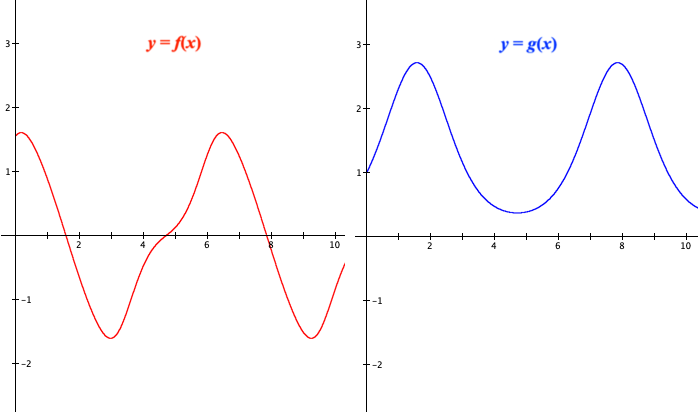| Sum: |
The sum of two functions is a function. Suppose you have
two functions f and g. A function
h, defined as $h(x)=f(x)+g(x)$, is called the sum
of f and g. Every value of h is a
sum of a value of f and a value of g.
The sum function is conventionally written as
"$(f+g)$". So $(f+g)(x)=f(x)+g(x)$
Take note: The character "+" in "$(f+g)$" has
a diffent meaning than "+" in $f(x)+g(x)$. In "$(f +
g)$", "+" is a character in the sum function's name.
In "$f(x)+g(x)$", "+" is the arithmetical operation
"plus".
A sum of two functions is defined only for values
where each function is defined. For example, let
f be defined as $f(x)=2x$ and let
g be defined as $g(x) = 1/(x-2)$. Then $(f+g)(2)$ is undefined because $g(2)$ is undefined.
|
| Product: |
The product of two functions is a function. Suppose you
have two functions f and g. A function
p, defined as $p(x)=f(x)\cdot g(x)$, is called
the product of f and g. Every value of
p is a product of a value of f and a value
of g.
The product function is conventionally written as
"$(f\times g)$" or, more commonly, as "$(f \cdot
g)$". So $(f\cdot g)(x)=f(x)\cdot g(x)$
Take note: The character "$\cdot$" in
"$(f\cdot g)$" has a diffent meaning than "$\cdot$"
in $f(x)\cdot g(x)$. In "$(f\cdot g)$", "$\cdot$" is
a character in the product function's name. In
"$f(x)\cdot g(x)$", "$\cdot$" is the arithmetical
operation "times".
A product of two functions is defined only for
values where each function is defined. For example,
let
f be defined as $f(x)=2x$ and let g be defined as
$g(x)=1/(x-2)$. Then
$(f\cdot g)(2)$ is undefined because $g(2)$
is undefined.
|
| Quotient: |
The quotient of two functions is a function. Suppose you
have two functions f and g. A function
q, defined as $q(x)= f(x)/g(x)$, is called the
quotient of f and g. Every value of
q is a quotient of a value of f and a
value of g. If f and g are
polynomial functions, then q is called a rational
function.
The quotient function is conventionally written as
"$(f / g)$". So $(f / g)(x)=f(x)/g(x)$
Take note: The character "/" in "$(f/g)$" has
a diffent meaning than "/" in $f(x)/g(x)$. In
"$(f/g)$", "/" is a character in the quotient
function's name. In "$f(x)/g(x)$", "/" is the
arithmetical operation "division".
A quotient of two functions f and
g is defined only for values where each
function is defined and for values of x such
that $g(x)\neq 0$. For example, let f be
defined as f(x) = 2x and let
g be defined as $g(x)=2-x$. Then $(f/g)(2)$
is undefined because $g(2)=0$.
|
| Power: |
A power of a function is a function. Suppose you have
two functions f and g. A function
s, defined as $s(x)=f(x)^{g(x)}$, is called
f to the power of g. Every value of
s is a value of f raised to a power of
g. If f is a constant function, such as
$f(x)=3$, then
$s(x)=3^{g(x)}$ is called an exponential function.
The power function is conventionally written as "$(f
\,\text{^}\, g)$". So $(f \,\text{^}\,
g)(x)=f(x)^{g(x)}$
Take note: The character "^" in
"$(f\,\text{^}\, g)$" has a diffent meaning than "^"
in $f(x)\,\text{^}\,g(x)$ (or $f(x)^{g(x)}$). In
"$(f\,\text{^}\,g)$", "^" is a character in the
power function's name. In "$f(x)\,\text{^}\,g(x)$",
"^" is the arithmetical operation "power".
A power function is defined only for values where
each function is defined. Also, a power of
f is undefined when $f(x)\lt 0$ and $g(x)$ is
not an integer. For example, let f be
defined as $f(x)=2x$ and let g be defined
as $g(x)=1/(x-2)$. Then $(f\,\text{^}\,g)(2)$ is
undefined because $g(2)$ is undefined.
Similarly, if $f(x)=\cos(x)$ and $g(x)=\sin(x)$,
then $g(x)\,\text{^}\,f(x)$ is undefined whenever
$\sin(x)\lt 0$.
|
| Composite: |
Suppose you have two functions f and g. A
function c, defined as $c(x)=f(g(x))$
is called the
composition of f and g. Every value of
c is the value of f evaluated at a value
of g.
You have seen many examples of composite
functions. For example, when we define c as $c(x)=
\sin(3x+2)$ we have defined a composite
function. Think of g as $g(x)=3x+2$ and think of f as $f(x)=\sin(x)$. Then $f(g(x))=\sin(3x+2)$. Any function with a complicated argument is a composite function.
The composite function is conventionally written as
"$(f \circ g)$". So $(f \circ g)(x)=f(g(x))$.
The composite function $f(g(x))$ is defined only for
values of f that are in the domain of
g’s independent variable.
|
